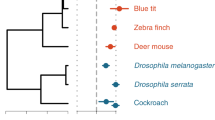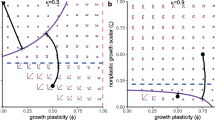Summary
The maximum intrinsic rate of increase (r max ) shows a −0.25 scaling with adult body weight (W) in mammals (and others). Average adult life span (1/M) and age at maturity (α) show −0.25 scalings, independent of population size; these two lead to ther max scaling, providedR o is invariant with body size in rarified populations (=R om ). Thus ther max scaling follows from the existence of two population size symmetries (i.e. 1/M and α) and one body size symmetry (R o ). The theory provides a formula to calculate the height (A 3) of the scalingr max =A 3 ·W −0.25. The theory also helps to explain ‘Fowler's Rules’, which linkR om to the relative position of the inflection point of the population growth curve.
Similar content being viewed by others
References
Blueweiss, L., Fox, H., Kudzma, V., Nakashima, D., Peters, R. and Sams, S. (1978) Relationship between body size and some life history parameters.Oecologia 37, 257–72.
Calder, W. A. (1984)Size, Function and Life History. Harvard Univ. Press, Cambridge.
Caughley, G. and Krebs, C. J. (1983) Are big mammals simply little mammals writ large?Oecologia 59, 7–17.
Charnov, E. L. (1990) On evolution of age at maturity and the adult life span.J. Evol. Biol. 3, 139–44.
Charnov, E. L. (1991a) Evolution of life history variation among female mammals.Proc. Natn. Acad. Sci. USA 88, 1134–7.
Charnov, E. L. (1991b) Pure numbers, invariants and symmetry in the evolution of life histories.Evol. Ecol. 5, 339–42.
Fenchel, T. (1974) Intrinsic rate of natural increase: the relationship with body size.Oecologia 14, 317–26.
Fowler, C. W. (1987) A review of density dependence in populations of large mammals. InCurrent Mammalogy (H. Genoways, ed.) pp. 401–41, Plenum Press, New York.
Fowler, C. W. (1988) Population dynamics as related to rate of increase per generation.Evol. Ecol. 2, 197–204.
Hennemann, W. W. (1983) Relationship among body mass, metabolic rate and the intrinsic rate of natural increase in mammals.Oecologia 56, 104–8.
Millar, J. S. and Zammuto, R. M. (1983) Life histories of mammals: an analysis of life tables.Ecolog 64, 631–5.
Peters, R. H. (1983)The Ecological Implications of Body Size. Cambridge University Press, New York.
Author information
Authors and Affiliations
Rights and permissions
About this article
Cite this article
Charnov, E.L. Allometric aspects of population dynamics: A symmetry approach. Evol Ecol 6, 307–311 (1992). https://doi.org/10.1007/BF02270967
Issue Date:
DOI: https://doi.org/10.1007/BF02270967




